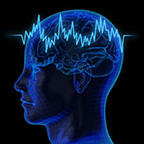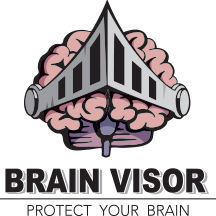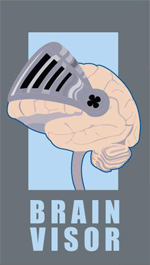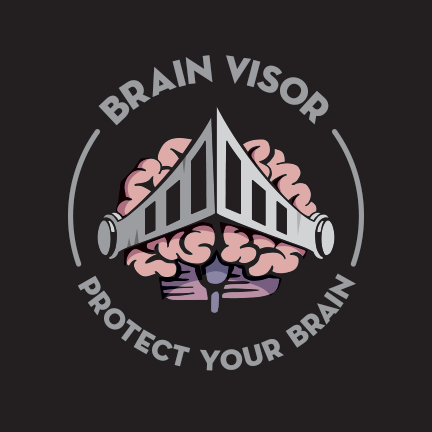
Psychiatric Disorders
Psychiatric or behavioral disorders primarily stem from biochemical, anatomical, and genetic factors. These brain diseases can produce relatively severe psychological disturbance. While not comprehensive, the following psychiatric disorders are briefly described in terms of associated symptoms and brain abnormalities.
Schizophrenia
Due to the literal ‘split mind’ definition, schizophrenia is often colloquially misunderstood. While generally easier to identify than define, the disorder is highlighted by “prefrontal inefficiency” (Hariri, 2015). Hallmark symptoms include:
- Delusions or beliefs that distort reality
- Hallucinations or altered perceptions, such as hearing voices
- Disorganized speech
- Disorganized and/or agitated behavior
- Absence of normal response: blunted emotions; loss of interest or drive
Hariri (2015) describes schizophrenia as “near-complete disintegration of the ability to integrate higher mental processes—including cognition, emotion, and motivation—in the service of generating adaptive behavioral response” (p. 192).
Results from numerous studies have implicated various potential structural abnormalities:
- Schizophrenic brains tend to weigh less than normal brains. Specific structures showing size reduction include: hippocampus, amygdala, superior temporal gyri, prefrontal cortex, thalamus, anterior cingulate, and corpus callosum
- Enlarged ventricles
- White matter pathology and disconnectivity
- Reduction of neurons in the dorsolateral prefrontal cortex and interconnected prefrontal regions
- The reduction in cortical volume may result from loss of neuropil and synapses and reflect an exaggeration of the normal synaptic pruning that occurs during adolescence (Goldstein, Brown, Haas, & Allen, 2013).
Neurocognitive deficits:
- Poorer performance on tests of long-term verbal and non-verbal memory
- Poorer performance on tests sensitive to frontal-lobe function (WCST, CPT, MATRICS, TMT)
Recommended websites:
- Schizophrenia.com
- National Institute of Mental Health (Schizophrenia)
Clinical Depressive Disorder
- Prefrontal cortex and its subcortical connections (cingulate cortex, hippocampus)
- Increased activity in the insula and dorsal anterior cingulate cortex
- Hyperactivity of the dorsomedial prefrontal cortex
- Weak connectivity between the amygdala and both the dorsomedial prefrontal cortex and ventromedial prefrontal cortex (failure to appropriately regulate the amygdala)
Additional pathophysiology studies have implicated specific neurochemical and metabolic disturbances:
- HPA axis – an over secretion of hydrocortisone by adrenal glands
- Decreased blood flow in the dorsolateral and medial prefrontal areas
- Increased blood flow in the amygdala and medial thalamus
- Serotonin deficit
- Norepinephrine and Epinephrine imbalance
- Dopamine deficit
- Glutamate imbalance
Neurocognitive deficits:
- Slowed mental processing
- Mild attention deficits
- Impaired memory performance (contradictory findings)
Recommended websites:
- Anxiety and Depression Association of America (ADAA)
- National institute of Mental Health (Depression)
Bipolar Disorder
- A decrease in gray matter in the anterior cingulate, ventral striatum, fusiform gyrus, hippocampus, and cerebellum
- In a depressive episode there is decreased activity in the ventromedial and dorsomedial prefrontal regions
- The ventrolateral prefrontal cortex appears unable to regulate amygdala activity
- Differences found in the lateral ventricles, third ventricle, left subgenual prefrontal cortex, amygdala, thalamus, and increased hyperintensities in white matter regions (Thaler, Allen, Goldstein, 2013).
Neurocognitive deficits:
- Poorer performance on verbal learning tasks (verbal memory impairment)
- Impairments in verbal memory in euthymic patients
- Impairments in sustained attention in euthymic patients
- Deficits in nonverbal learning in manic episodes
- Lower performances on measures of intelligence during mania
Recommended web sites:
- Depression and Bipolar Alliance (DBSA)
- National institute of Mental Health (Bipolar)
Anxiety Disorders
- Generalized Anxiety Disorder (GAD)
- decreased ventromedial prefrontal cortex activity
- decreased functional connectivity between the amygdala and medial prefrontal cortex
- persistent hyperactivity of the bed nucleus of the stria terminalis (Hariri, 2015)
- Panic Disorder (PD)
- amygdala hyperactivity
- decreased prefrontal cortex activity
- insula hyperactivity
- Hariri (2015) suggests that amygdala and insula hyperactivity may be a state feature (occurring only during panic attack)s, while prefrontal cortex hypoactivity may be a trait feature (occurring in response to negative emotional information) (p. 65).
- Social Anxiety Disorder (SAD)
- amygdala hyperactivity
- decreased functional connectivity between the amygdala and ventromedial prefrontal cortex
- Specific Phobia
- amygdala hyperactivity
- insula hyperactivity
- increased activity in the dorsomedial prefrontal cortex
- Posttraumatic Stress Disorder (PTSD)
- amygdala hyperactivity
- abnormal activity in the hippocampal formation
- medial prefrontal cortex hypoactivity
Neurocognitive deficits:
- General attention and executive dysfunction
- Impaired working memory due to cognitive interference
- Attentional bias
- Impaired cognitive control
Recommended websites:
- Anxiety and Depression Association of America (ADAA)
- National Institute of Mental Health (Anxiety Disorders)
Obsessive Compulsive Disorder
- Reduced volume of the left anterior cingulate cortex
- Reduced volume of the left and right orbitofrontal cortex
- Increased volume of the thalamus bilaterally
- Dorsolateral prefrontal cortex dysfunction
- Dorsal striatum hypoactivity
- Ventral lateral prefrontal cortex dysfunction
- Ventromedial prefrontal cortex dysfunction
- Dorsal anterior cingulate cortex hyperactivity
- Hippocampus volume loss and shape abnormalities
- White matter pathways abnormalities
Neurocognitive deficits:
- Abnormal sustained attention (inability to shift attention away from intrusive thoughts)
- Deficits in response inhibition
- Deficits in cognitive flexibility
- Difficulties with inferential reasoning
- Difficulties with decision making
Recommended websites:
- International OCD Foundation
- Anxiety and Depression Association of America (ADAA)
- National Institute of Mental Health (OCD)
- BrainPhysics.com
Personality Disorders
TBA
References
Goldstein, G., Brown, L.H., Haas, G.L., & Allen, D.N. (2013). Schizophrenia. In C.A. Noggle & R.S. Dean (Eds.), The neuropsychology of psychopathology (pp. 325- 343). New York: Springer Publications.
Hariri AR (2015) Looking inside the disordered brain. Sunderland, MA: Sinauer Associates.
Thaler, N.S., Allen, D.N., & Goldsein, G. (2013) Bipolar Disorders. In C.A. Noggle & R.S. Dean (Eds.), The neuropsychology of psychopathology (pp. 221-242). New York: Springer Publications.
 |
BrainVisor – Protect Your BrainBrainVisor does not provide medical or psychological advice, diagnosis or treatment recommendations. The material on this site is for informational purposes only and is not a substitute for your doctor or other health care professional's care.
|
 |
||
|









